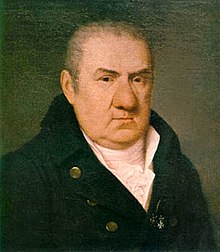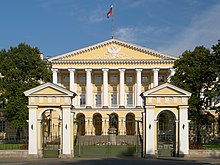Giacomo Quarenghi
Giacomo Quarenghi [dʒaːkomo kwareŋɡi] (* 20th September 1744 in Rota d'Imagna , province of Bergamo , † February 18 . Jul / 2. March 1817 greg. In Saint Petersburg ) was an Italian architect and painter in Russia lived and worked. As one of the most renowned Russian architects and builders of the late 18th century, he created a large number of buildings that are still known today, especially in Saint Petersburg and Moscow .
biography
Quarenghi was born in the Bergamo province of Lombardy and came from a noble family there. He studied painting in Rome , where his teachers included Anton Raphael Mengs . Quarenghi later studied architecture, where he was mainly inspired by ancient architecture and masters such as Andrea Palladio . Quarenghi's early works include several buildings in his homeland (including the Cathedral of St. Scholastica in Subiaco , which Quarenghi had the inside rebuilt in the classical style in the early 1770s ), but also in Monaco and Vienna .
In 1779 Quarenghi went to Russia after he was appointed there as one of the many Italian master builders who were involved in the construction of the new imperial capital St. Petersburg , founded in 1703 . There he first worked in the old capital Moscow and rebuilt the (no longer preserved) palace of Catherine the Great on the Jausa River . The predecessor building of the Upper Ranks on Red Square is also attributed to Giacomo Quarenghi.
From 1781 Quarenghi lived and worked in Saint Petersburg, where he initially designed several representative buildings on behalf of Catherine the Great, including the no longer preserved English Palace (1781–1794) in Peterhof , the Hermitage Theater (1783–1787) and the building the Imperial Russian Academy of Sciences (1783–1785). The Alexander Palace (1792–1796) in Tsarskoye Selo and a side wing of the Catherine Palace are also among the most important buildings in Quarenghi during the reign of Catherine the Great .
Quarenghi also created a number of important buildings under Katharina's successor Paul I and later under his successor Alexander I. The building of the Smolny Institute (1806), the Marienkrankenhaus (1803) originally intended for poor people, the Maltese Church (1798–1800) (Paul I was Grand Master of the Order of Malta ) and the Cabinet of His Imperial Majesty before the Anichkov Palace . In addition to the capital, Quarenghi also had commissions in several provincial towns: for example, striking mansions and palaces, some of which have survived to this day, were built according to his designs in Kursk , Surash and Voronezh, as well as in Mežotne in Latvia and Irkutsk in Siberia .
Quarenghi was an honorary member of the Petersburg Art Academy . After his death, his son published a complete list of Quarenghi's designs in Milan in 1821 , which appeared under the name Fabbriche e Disegni di Giacomo Guarenghi .
Giacomo Quarenghi is still considered to be one of the pioneers of later classicism in the architecture of Russian cities, although his works were in part also inspired by ancient architecture. Quarenghi has also left striking traces as a painter: numerous watercolors he created with city views of Moscow and Petersburg have been preserved.
literature
- Constantin von Wurzbach : Querenghi, Jacob . In: Biographisches Lexikon des Kaiserthums Oesterreich . 24th part. Imperial-Royal Court and State Printing Office, Vienna 1872, p. 143 f. ( Digitized version ).
Web links
- Biography on krugosvet.ru (Russian)
- Short biography on rulex.ru (Russian)
- Entry about Giacomo Quarenghi on Artisti Italiani in Austria , a project of the University of Innsbruck
- Andrea Klasen: March 2nd, 1817 - Anniversary of the death of Giacomo Quarenghi WDR ZeitZeichen on March 2nd, 2017. (Podcast)
| personal data | |
|---|---|
| SURNAME | Quarenghi, Giacomo |
| ALTERNATIVE NAMES | Quarenghi, Giacomo Antonio Domenico |
| BRIEF DESCRIPTION | Italian-Russian architect |
| DATE OF BIRTH | September 20, 1744 |
| PLACE OF BIRTH | Rota d'Imagna |
| DATE OF DEATH | March 2, 1817 |
| Place of death | St. Petersburg |

